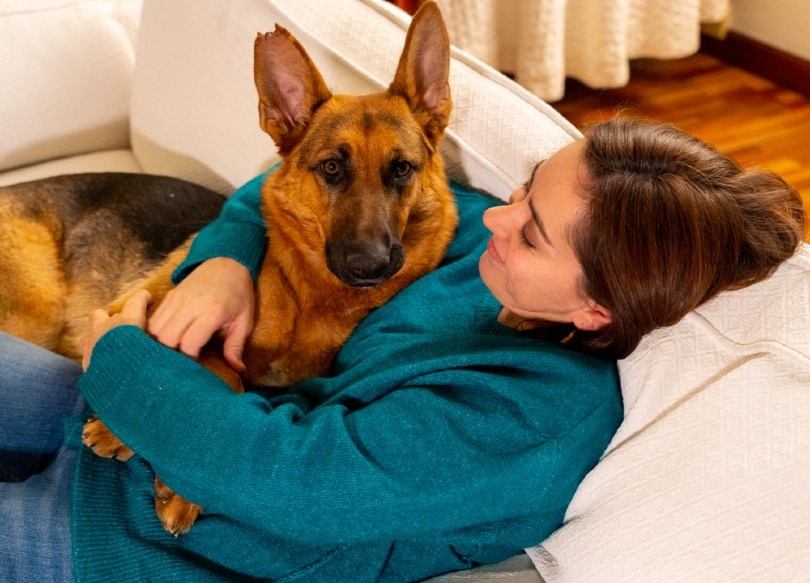Fear of Dogs in People: Understanding Cynophobia
Updated on

As a dog lover, it may come as a surprise to hear that some people have a deep fear of dogs. In fact, this fear is real and common enough that there is a name for it, called cynophobia. Cynophobia can affect a person’s life drastically because there are dogs all over the United States. You can hear them barking in the distance, you walk past them in the street, and there may even be dogs at certain restaurants or hotels you love because they’re pet-friendly.
People with cynophobia will often avoid places where dogs have access to or will likely be, which stops them from joining in on certain special occasions, walks, and socials at homes with dogs. The good news is that people with cynophobia are not alone, and there are steps to take to overcome this intense fear.
How to Identify Cynophobia
Although some people with cynophobia have it worse than others, the phobia can be so intense that hearing a dog bark, thinking about dogs, or even holding a toy dog can trigger an anxiety attack. As with all phobias, the fear is much worse than the reality, so what may seem irrational to someone without cynophobia may seem very rational to someone with it.
Symptoms of cynophobia are highly individual, and two people with this phobia may experience it completely differently, with one experiencing emotional symptoms and the other experiencing physical ones.
- Difficulty breathing
- Trembling
- Sweating
- Rapid heart rate
- Tightness in the chest
- Dizziness
- Upset stomach
- Anxiety attacks
- Feeling out of control
- Feeling faint
- Feeling powerless
- A need to get away from the dog
People who seek professional help are usually diagnosed with cynophobia quite easily as they will often meet the following criteria:
- Their fear and anxiety intensify when they are around dogs or have the potential of encountering a dog.
- They are aware that their fear of dogs is irrational and greater than the threat of the dog.
- They go out of their way to avoid dogs.
- They have had this fear for longer than 6 months.

How Common Is Cynophobia?
It’s hard to know the exact number of people who have cynophobia because many people live with the phobia without ever seeking treatment for it. However, it is believed that around 7% – 9% of the population struggle with phobias. It is common for people with phobias to be fearful of animals, which include dogs.
Who Is at Risk?
Women are more likely to struggle with phobias, but this condition isn’t unique to women. Men and children can also struggle with cynophobia. People with autism and similar conditions are at a higher risk of cynophobia, but it is also commonly found in people with depression, anxiety, obsessive disorders, panic attacks, and substance abuse disorders.
Cynophobia is also common among people who have had a negative experience with dogs in the past. People who have been bitten by a dog or who have been chased by a vicious dog often struggle to trust dogs again and can develop an intense fear of them.
Sometimes the phobia can even develop from an experience with a dog that almost happened but didn’t. Other times it can develop from witnessing or hearing about someone else’s negative experience with a dog. Cynophobia can also develop in children who have parents or caregivers who have an intense fear of dogs because they have witnessed their fear and learned to be fearful too.

Can You Overcome Cynophobia?
In most cases, people who undergo therapy or take the necessary steps to overcome cynophobia are usually successful and can live relatively normal lives. If you’re at the point where you no longer want to leave your house in fear of encountering a dog, you should seek professional help due to the severity of your anxiety disorder. Therapy and medication might be necessary to help you cope and get your confidence back.
However, there are other ways to help you overcome cynophobia too. These different methods can be done with the help of your therapist, on your own, or with a friend.
One effective method is exposure therapy. This method requires you to be exposed to dogs. However, it can be done at your own pace. You don’t have to start out with being around a real dog; you can begin small by simply thinking about dogs. You can progress to looking at photos or videos of dogs and eventually watch dogs from a distance in person.
Only once you feel ready do you need to get near a dog and spend a bit of time with them. Throughout this process, you’ll notice that you’re becoming more and more desensitized to dogs and less fearful.
Other methods include breathing exercises, understanding why or what you’re afraid of when it comes to dogs, yoga, and hypnotherapy.
How to Avoid Cynophobia
Cynophobia usually develops in childhood, but it can also develop after a negative experience with a dog. If you have recently been attacked by a dog or witnessed an attack, seeking professional help could help you work through that experience and the emotions that accompany it.
Another way to avoid developing cynophobia is to be in the presence of a dog soon after your traumatic experience. Being around friendly dogs will remind you that not all dogs are dangerous and out to hurt people. Make sure that the dog you do interact with is calm and friendly, as a hyperactive dog might overwhelm you. Ask your friends or family members with dogs if you can spend some time with their dogs while they stand next to you or close by for reassurance.
Another great way to avoid this condition is to educate yourself on dogs and dog attacks. By doing this, you’ll learn how uncommon random dog attacks are. You can also educate yourself on the best way to behave around dogs so as not to hype them up or make them feel anxious or threatened. You can also learn about their behavior and what different body language in dogs indicates so that you can feel more confident when you’re around them.

Final Thoughts
Cynophobia is an irrational but intense fear of dogs. It can be as severe as not leaving your house in an effort to avoid any potential encounter with dogs. This phobia can develop in children or adults, especially if they have had a negative encounter with dogs in the past or suffer from other conditions, such as depression or autism. A person with cynophobia can react physically or emotionally to being in the presence of a dog but often are aware that their fear is greater than the threat of the dog.
There are several methods that can help a person overcome cynophobia partially or completely. These methods include talking about their fear to a professional, exposure therapy, medication, and breathing exercises.
- Related Read: Why Does My Dog Chase People? 7 Possible Reasons
Featured Image Credit: M-Production, Shutterstock











